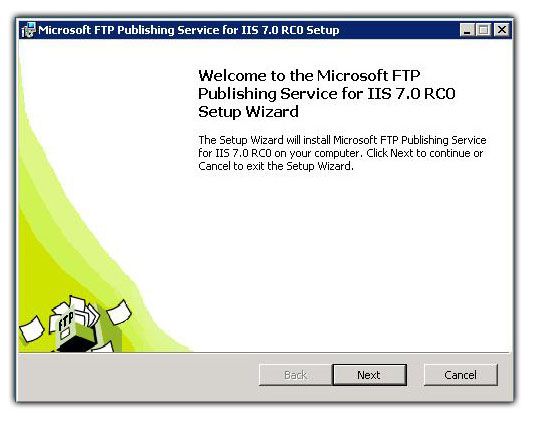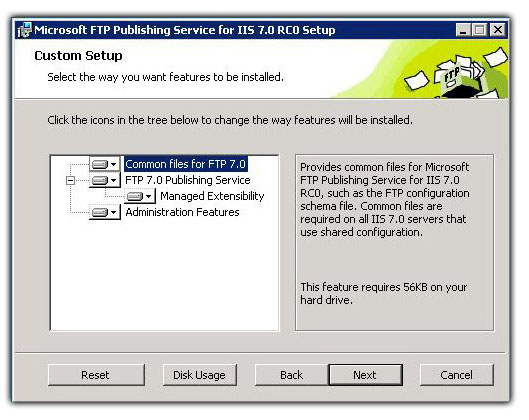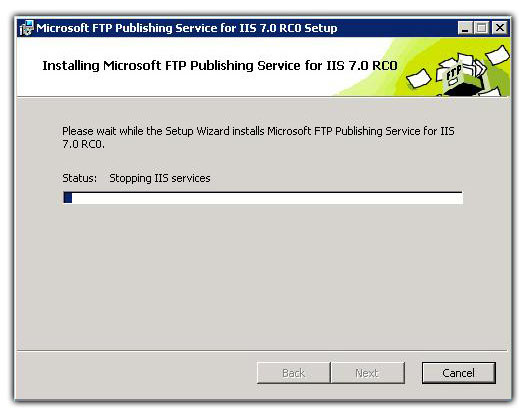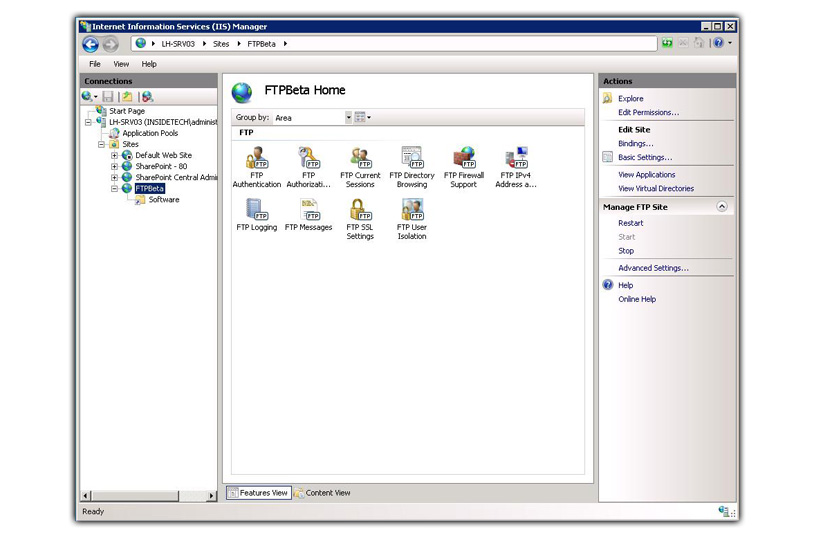Chi ha provato le versioni Beta di Windows Server 2008, si è accorto della mancanza, all'interno di Internet Information Services 7, della gestione nativa degli FTP. Chi voleva configurare un server FTP, doveva utilizzare la console presente in IIS6. Con l'arrivo della Release Candidate 0, il team di IIS ha messo a disposizione la prima ufficiale, e definitiva quasi sicuramente, versione per la gestione degli FTP, all'interno di Windows Server 2008. Questo articolo spiega, molto semplicemente, come installare FTP v7 e come cambia il panorama all'interno della console di IIS.
Spiegazione
Il tool è stato reso disponibile subito dopo l'uscita della RC0, questo indica che era in fase di lavorazione in modo separato dal resto del sistema operativo. Inoltre il download è possibile solo tramite il sito del team di IIS, questo in attesa che venga integrato nella RC1. Notare che questo pack richiedere obbligatoriamente l'ultima release di Windows Server 2008.
Una volta lanciato il setup - figura 1 - verrà avviato il wizard che vi guiderà nell'installazione del prodotto.

Figura 1 - Avvio dell'Installazione di FTP v7
Il wizard non richiede molto tempo e, ovviamente, stopperà il servizio di IIS per installare la nuova versione di gestione FTP. Le figure 2 e 3 mostrano lo svolgimento dell'installazione.


Figura 2/3 - Installazione di FTP v7
Terminata l'installazione potrete iniziare a lavorare con il nuovo sistema FTP, che troverete nella stessa console di IIS. Appena avviata la console - figura 4 -, si nota subito che è stata rimossa la voce FTP, questo perchè in Windows Server 2008, gli FTP sono considerati come dei siti web.

Figura 4 - La nuova interfaccia di IIS7
Le Novità della Versione 7
Ecco le novità che sono state integrate nella versione 7:
Integration with IIS 7.0: IIS 7.0 has a brand-new administration interface and configuration store, and the new FTP service is tightly integrated with this new design. The old IIS 6 metabase is gone, and a new configuration store that is based on the .NET XML-based *.config format has taken its place. In addition, IIS 7.0 has a new administration tool, and the new FTP server plugs seamlessly into that paradigm.
Support for new Internet standards: One of the most significant features in the new FTP server is support for FTP over SSL. The new FTP server also supports other Internet improvements such as UTF8 and IPv6.
Shared hosting improvements: By fully integrating into IIS 7.0, the new FTP server makes it possible to host FTP and Web content from the same site by simply adding an FTP binding to an existing Web site. In addition, the FTP server now has virtual host name support, making it possible to host multiple FTP sites on the same IP address. The new FTP server also has improved user isolation, now making it possible to isolate users through per-user virtual directories.
Extensibility and custom authentication: The new FTP server supports developer extensibility, making it possible for software vendors to write custom providers for FTP authentication. Microsoft is using this extensibility feature to implement two new methods for using non-Windows accounts for FTP authentication for IIS Managers and .NET Membership.
Improved logging support: FTP logging has been enhanced to include all FTP-related traffic, unique tracking for FTP sessions, FTP sub-statuses, additional detail fields in FTP logs, and much more.
New supportability features: IIS 7.0 has a new option to display detailed error messages for local users, and the FTP server supports this by providing detailed error responses when logging on locally to an FTP server. The FTP server also logs detailed information using Event Tracing for Windows (ETW), which provides additional detailed information for troubleshooting.
Gestione tramite file XML, supporto alle SSL, supporto all'IPv6, nuovo sistema di autenticazione, gestione degli eventi...insomma FTP v7 si presenta come una vera rivoluzione rispetto al suo predecessore, che era molto limitato.
Creando un nuovo FTP, avremo le proprietà in stile IIS7, ovvero con una panoramica delle opzioni che possiamo andare a modificare - figura 5.

Figura 5 - Proprietà FTP
Conclusioni
Il team di IIS ha lavorato molto, e in gran segreto, alla realizzazione di una versione innovativa per la gestione degli FTP. Microsoft deve ancora guadagnare parecchio terreno rispetto ai suoi avversari, sulla parte di Web Publishing, e con l'introduzione di IIS7, potrà ampiamente competere con i suoi competitor. Ora non ci resta che aspettare la versione definitiva, di Windows Server 2008, per capire quanto gli sforzi fatti dagli sviluppatori, abbiano sortito l'effetto desiderato.
Link Utili
http://www.iis.net/articles/view.aspx/IIS7/Managing-IIS7/Using-FTP-Server-in-IIS7/Installing-and-Troubleshooting-FTP7
http://www.iis.net/downloads/default.aspx?tabid=34&g=6&i=1526
Ciao ciao
S